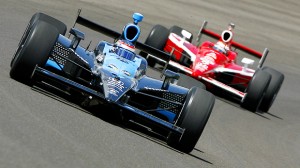
IndyCar Makes Switch to Bioethanol
When Ray Harroun won the inaugural Indianapolis 500, he roared across the finish line in a 1911 Marmon Wasp that was believed to have been the first car with a rear-view mirror.
On Saturday, Indy-style racecars once again will attempt to point the way for mass-produced passenger cars, staging the first automobile race run on 100 percent field-grade bioethanol. The IndyCar series plans to run its entire 17-race 2007 season, which kicks off at Homestead-Miami Speedway, using ethanol, making it the first series in motorsports to compete on a renewable fuel.
To mark the milestone, Indy Racing League President Tony George and driver Jeff Simmons (who pilots the No. 17 racecar sponsored by Team Ethanol) will join Indiana senators Evan Bayh (D) and Richard G. Lugar (R) at the Capitol today for a round of handshakes, photographs and interviews.
[ad]
“This shows average Americans what they can do to help meet the energy challenge our country faces, and it makes the point in a way a politician never could,” Bayh said in a telephone interview yesterday. “If a racecar going 220 miles an hour can be powered by 100 percent bioethanol, the family car can be, too.”
The open-wheel Indy cars have run on methanol since the late 1960s. The two fuels share many qualities; both are alcohol-based and have a higher octane rating than unleaded gasoline. But methanol is made from natural gas, a nonrenewable fossil fuel, while bioethanol is a renewable fuel made from agricultural products such as corn.
Moreover, there’s no performance drop-off with bioethanol, according to Simmons, who used the fuel in his racecar last season, as well. Simmons says that his racecar, powered by a Honda V-8 engine, actually accelerates better with bioethanol. It also gets better fuel mileage, which has enabled the Indy Racing League to downsize its cars’ fuel cells from 30 gallons to 22. On a full fuel load, that takes about 50 pounds out of the car’s overall weight, which improves performance.
Simmons says he’s comforted by the fact that ethanol is less lethal if it gets in your system. It also emits a slight orange glow and a faint amount of smoke when it burns. Methanol, by contrast, burns clear and, as a result, has been the cause of serious injuries in the pits because mechanics can’t detect fires right away.
Finally, racecar drivers say ethanol has a more pleasant smell than methanol. No doubt that improves the quality of life for drivers who can’t help but inhale the stuff over the course of a two-hour race. But Bayh hopes the average taxpayer sees a bigger benefit in the switch.
“My major interest in this is as a national security issue,” says Bayh, who earlier this year joined senators Norm Coleman (R-Minn.), Joseph I. Lieberman (I-Conn.) and Ken Salazar (D-Colo.) in introducing bipartisan legislation to reduce the country’s dependence on foreign oil by increasing the availability of ethanol and providing tax credits for manufacturers who retool their factories to build hybrid cars, among other measures. “Most people would agree it’s better to have American farmers producing our fuel than Middle East sheiks.”
NASCAR, the country’s most popular form of auto racing, has no plans to explore renewable fuels at the moment. Its attempt to switch from leaded gasoline to unleaded, which began in 1999, proved far more difficult than anticipated. After numerous engine failures and false starts, a suitable unleaded racing fuel was developed, and NASCAR Nextel Cup series switched to unleaded fuel last month at Fontana, Calif.
Source Washington Post

